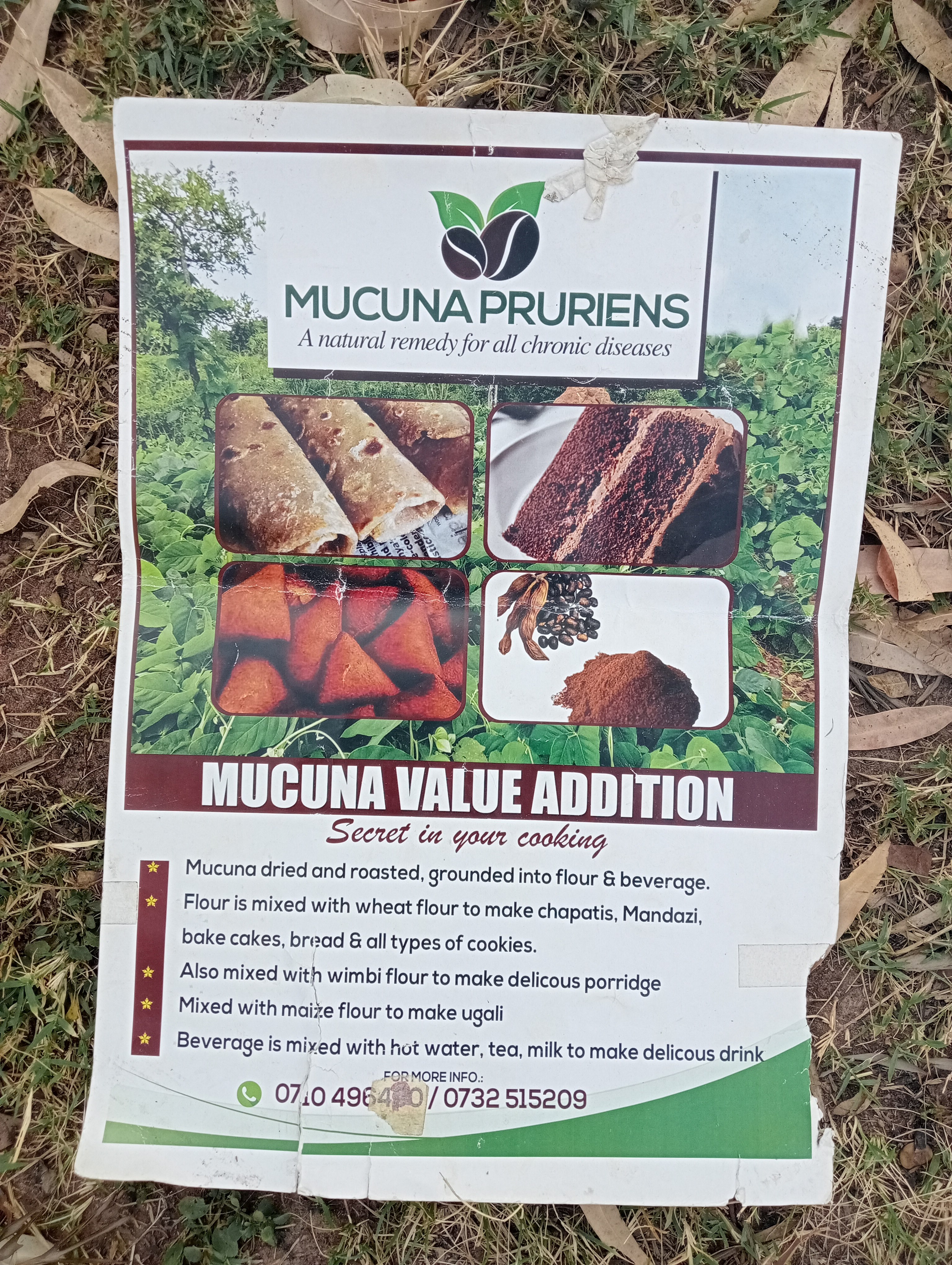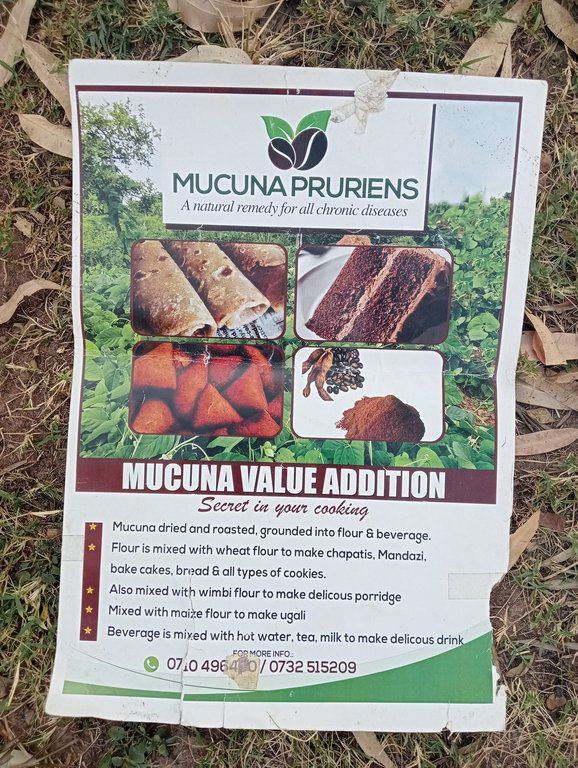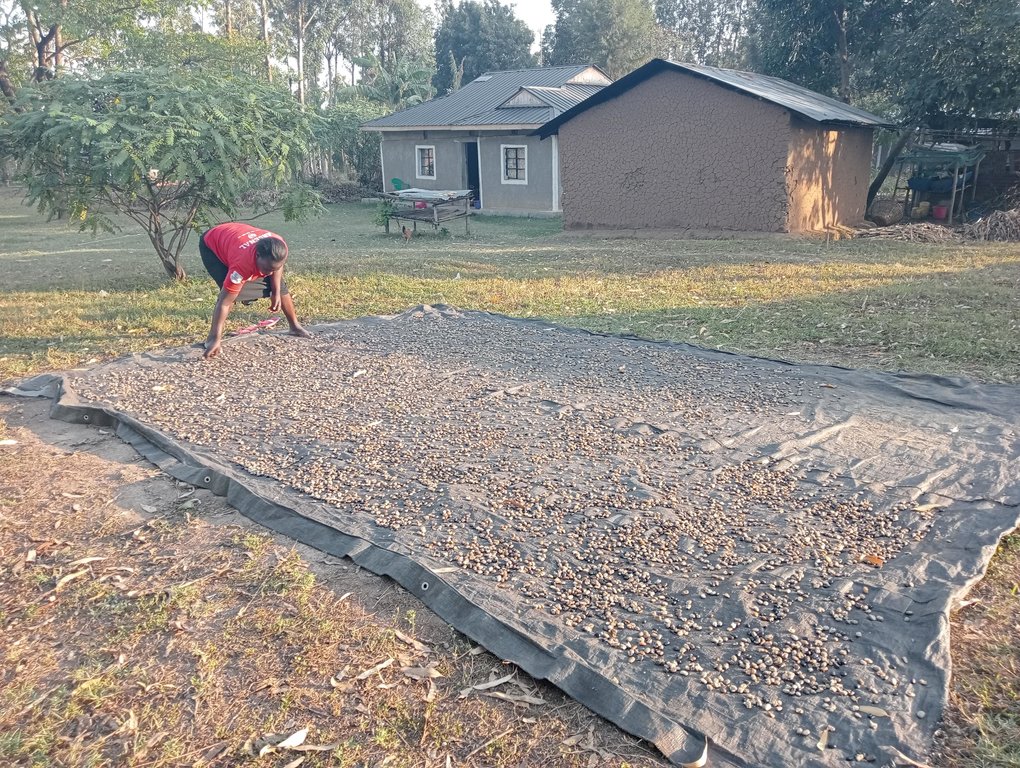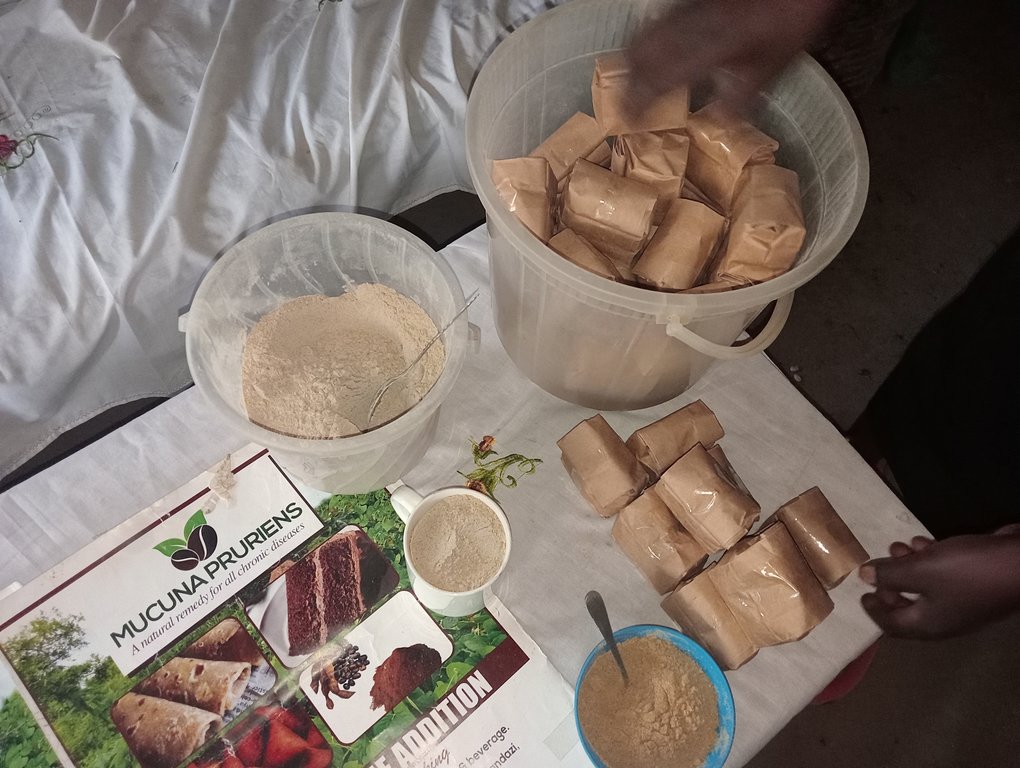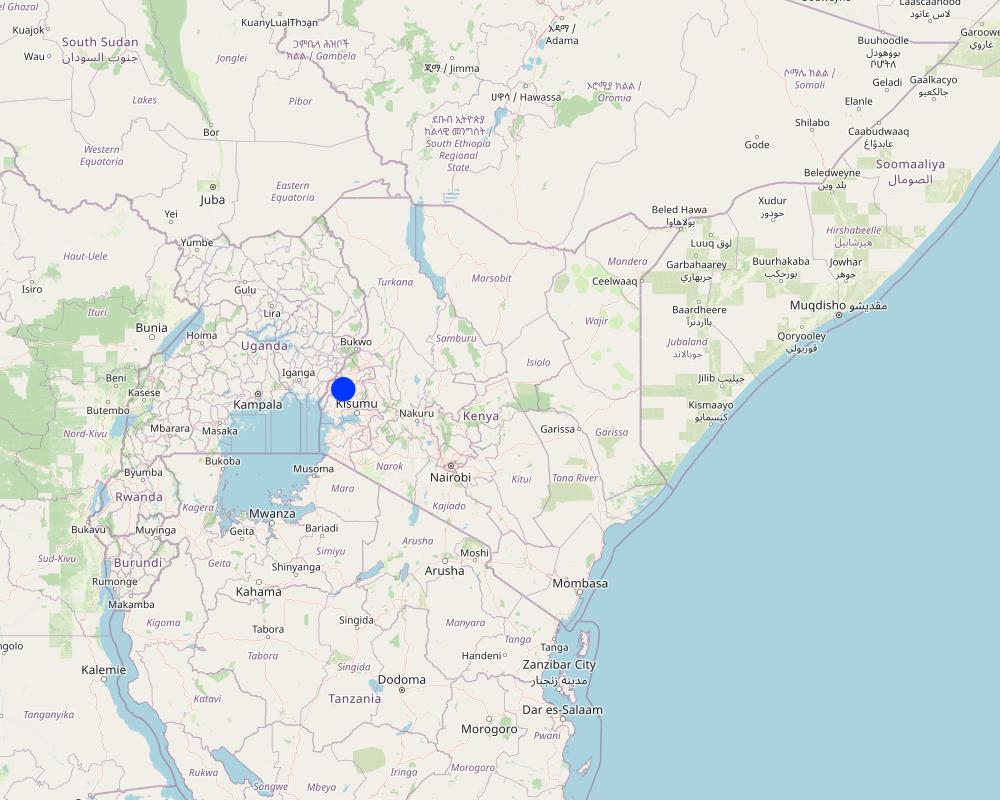Mucuna value-addition for female farmers [Kenia]
- Creación:
- Actualización:
- Compilador: William Akwanyi
- Editores: George Onyango, Innocent Faith, Noel Templer, Tabitha Nekesa, Ahmadou Gaye, Siagbé Golli
- Revisores: William Critchley, Rima Mekdaschi Studer, Sally Bunning
N/A
approaches_6684 - Kenia
Visualizar secciones
Expandir todo Colapsar todos1. Información general
1.2 Detalles de contacto de las personas de referencia e instituciones involucradas en la evaluación y la documentación del Enfoque
Persona(s) de referencia clave/s
Usuario de la tierra:
Asievela Rebecca
+254 714 890016 / +254 731 265120
rebecca.asievela@gmail.com / N/A
Welthungerhilfe farmer
Rebecca Asievela's farm in Emachina Village, Koyonzo Ward, Matungu Sub-county, Kakamega County
Kenia
Especialista MST:
Especialista MST:
Nombre del proyecto que facilitó la documentación/ evaluación del Enfoque (si fuera relevante)
Soil protection and rehabilitation for food security (ProSo(i)l)Nombre de la(s) institución(es) que facilitaron la documentación/ evaluación del Enfoque si fuera relevante)
Deutsche Gesellschaft für Internationale Zusammenarbeit (GIZ)Nombre de la(s) institución(es) que facilitaron la documentación/ evaluación del Enfoque si fuera relevante)
CIAT International Center for Tropical Agriculture (CIAT International Center for Tropical Agriculture) - Kenia1.3 Condiciones referidas al uso de datos documentados mediante WOCAT
¿Cuándo se compilaron los datos (en el campo)?
28/01/2023
El compilador y la/s persona(s) de referencia claves aceptan las condiciones acerca del uso de los datos documentados mediante WOCAT :
Sí
1.4 Referencia/s al/los Cuestionario(s) de Tecnologías MST
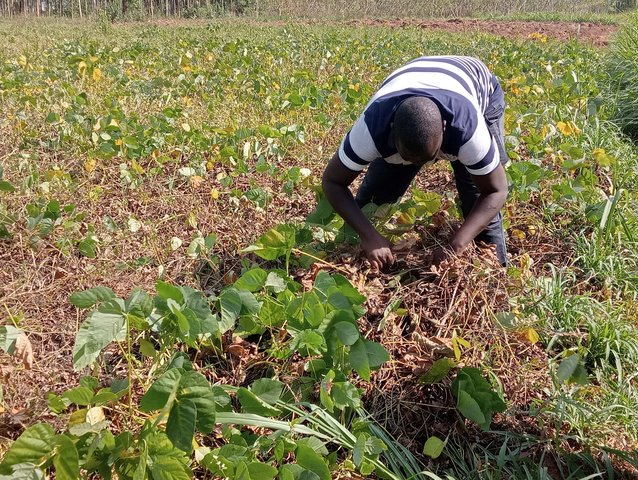
Permanent soil cover [Kenia]
Permanent soil cover with cover crops and/or crop residues helps to control soil erosion, suppress weeds and build up soil fertility. It can also add organic matter to the soil.
- Compilador: William Akwanyi
2. Descripción del Enfoque MST
2.1 Breve descripción del Enfoque
Promoting mucuna seed processing for food and nutrition security and income generation encourages women farmers to plant mucuna as a cover crop that improves soil productivity.
2.2 Descripción detallada del Enfoque MST
Descripción detallada del Enfoque MST:
Mucuna pruriens (velvet bean) is tropical legume that is widely known for its ability to rehabilitate soils by increasing organic matter. Unlike many other legumes of the bean family, mucuna seeds (beans) are not very palatable. In addition, raw and unprepared mucuna beans can cause severe digestive disorders. However, due to its emerging health and economic benefits, many farmers are now adopting the crop. Consequently, the crop is simultaneously helping in soil conservation by controlling soil erosion and improving soil structure alongside suppressing weeds.
Promoting the economic benefits of mucuna through value addition is a key factor in ensuring farmers adopt mucuna as a conservation agriculture crop. Mucuna value addition involves various stages of beans preparation/ treatment aimed at reducing the potential of L-DOPA toxicity. The ProSoil project promoted the uptake of mucuna as a green manure cover crop by training farmers on mucuna bean value-addition. In Matungu area of Kakamega County, Kenya, the ProSoil project partnered with a local farmer-based self-help group, Tunza Udongo Self Help Group [‘tunza udongo’ is a Kiswahili phrase for ‘take care of the soil’] which facilitated the convening women farmers. The project facilitated specialists in mucuna value addition from the Ministry of Agriculture who trained the farmers.
To spread this approach, the trained farmers train other farmers. In addition to the training in mucuna value-addition, the farmers were informed about the ecological and economic importance of mucuna and its propagation. The ProSoil project (GIZ and WHH) and Ministry of Agriculture invite the farmers to events such as farmer field days where they can exhibit different products from mucuna, network, and link up with potential markets. On the other hand, Tunza Udongo Self Help plays an important role in collective marketing.
One aim of promoting mucuna value addition is to increase its uptake by farmers as a green manure cover crop which is an important measure in conservation agriculture. Mucuna beans preparation is a domestic chore equivalent to other chores that are traditionally performed by women. Consequently, the entire farming household benefits from the income from the sale of mucuna products (skin free beans, flour, beverage, and baked products). The prices of these products vary in time and space depending on the availability of and demand for the products. However, the average prices are KES 100.00 per kg of skin free beans, KES 120.00 per kg of flour, and KES 150.00 per kg of beverage. Farmers also sell unprocessed mucuna beans as seed at KES 100.00 – 200.00 per kg depending on the availability of, and demand for, the seeds.
2.3 Fotos del Enfoque
Comentarios generales sobre las fotos:
Processing of mucuna beans only requires equipment that are available in most households.
2.4 Videos del Enfoque
Comentarios, descripción breve:
https://vimeo.com/manage/videos/807802820/privacy
Winnowing boiled and sun-dried mucuna beans to remove skin.
Fecha:
28/01/2023
Lugar:
Rebecca Asievela's farm in Emachina Village, Koyonzo Ward, Matungu Sub-county, Kakamega County
Nombre del videógrafo:
William Akwanyi
2.5 País/ región/ lugares donde el Enfoque fue aplicado
País:
Kenia
Región/ Estado/ Provincia:
Kakamega County in western Kenya
Especifique más el lugar :
Emachina Village, Ejinja Sub-location, Koyonzo Location, Koyonzo Ward, Matungu Sub-county
Comentarios:
GPS coordinates collected at the farm are 0.425487, 34.460523,
Map
×2.6 Fechas de inicio y conclusión del Enfoque
Indique año del inicio:
2019
Comentarios:
The approach is still being applied as many farmers are continuing to add value to mucuna and selling the products.
2.7 Tipo de Enfoque
- proyecto/ basado en un programa
2.8 Propósitos/ objetivos principales del Enfoque
To increase its farmers' uptake of mucuna as a green manure cover crop which is an important measure in conservation agriculture.
2.9 Condiciones que facilitan o impiden la implementación de la/s Tecnología/s aplicadas bajo el Enfoque
normas y valores sociales/ culturales/ religiosos
- facilitan
Perceived health benefits of mucuna and food and nutritional value.
colaboración/ coordinación de actores
- facilitan
Market linkages by GIZ and Welthungerhilfe partners.
gobernanza de tierras (toma de decisiones, implementación y aplicación)
- facilitan
Like many other crops of the bean family, mucuna is entirely managed by women.
conocimiento de MST, acceso a apoyo técnico
- facilitan
Training by Welthungerhilfe specialists.
mercados (para comprar insumos, vender productos) y precios
- facilitan
Availability of market as a result of increasing demand for mucuna products due to perceived health benefits of mucuna.
carga de trabajo, disponibilidad de mano de obra
- facilitan
Processing requires equipment that are commonly available in most households.
- impiden
Processing of mucuna beans is labour intensive.
otros
- facilitan
Githeri is Kenyan traditional meal, especially in Central Kenya. Adding processed mucuna beans to githeri makes it appealing. This is a motivation for many farmers to adopt mucuna.
3. Participación y roles de las partes interesadas involucradas
3.1 Partes interesadas involucradas en el Enfoque y sus roles
- usuarios locales de tierras/ comunidades locales
The farmers in the area who are mostly small-scale farmers due to the small parcels of land. Women farmers constituted 75%.
Mucuna value addition is a domestic chore equivalent to other women centric domestic chores that are traditionally performed by women. Hence, commonly done by women who are targeted by the value addition. However, the end result benefits the entire farming household.
- organizaciones comunitarias
Tunza Udongo Self-Help Group
Convening farmers for training.
- especialistas MST/consejeros agrícolas
GIZ ProSoil project SLM specialists and specialists from the implementing partner, Welthungerhilfe.
Provided technical advice to the farmers on how to process mucuna as a way of encouraging households to adopt mucuna as a green manure cover crop.
- gobierno local
Extension staff from the county department of agriculture
Training farmers
- organización internacional
GIZ
Financial support to the technical team and farmers during capacity building.
Si varias partes interesadas estuvieron involucradas, indique la agencia principal:
GIZ
3.2 Involucramiento de los usuarios locales de tierras/ comunidades locales en las distintas fases del Enfoque
| Involucramiento de los usuarios locales de tierras/ comunidades locales | Especifique quién se involucró y describa las actividades | |
|---|---|---|
| iniciación/ motivación | auto-movilización | Farmers involved in the training on mucuna value addition. |
| planificación | interactivo | Farmers consulted on where and when to conduct trainings and demonstrate mucuna value-addition. |
| implementación | auto-movilización | Each farmer processes his/ her own mucuna and decides on whether or not to sell the surplus products. Farmers look for their own markets. GIZ and Welthungerhilfe may link farmers to potential buyers. |
| monitoreo y evaluación | pasivo | Interviews with implementing farmers. |
| ninguno |
3.3 Flujograma (si estuviera disponible)
Descripción:
The ProSoil Project consists of GIZ and the implementing partners in this case Welthungerhilfe (WHH). The project provides financial support to farmers through their groups for convening farmers for the trainings. The farmers are trained by technical staff from the County Ministry of Agriculture and sometimes by specialists from the ProSoil project. The county technical staff (trainers) are paid by the project through either GIZ or WHH.
Autor:
William Akwanyi
3.4 La toma de decisiones en la selección de Tecnología(s) MST
Especifique quién decidió la selección de las Tecnología/ Tecnologías a implementarse:
- principalmente usuarios de tierras con el apoyo de especialistas MST
Explique:
Decisions on what products to produce from mucuna were made mainly by land users supported by SLM specialists.
Especifique las bases que sustentaron la toma de decisiones:
- la evaluación de conocimiento MST bien documentado (la toma de decisiones se basa en evidencia)
- la experiencia personal y opiniones (no documentadas)
4. Apoyo técnico, fortalecimiento institucional y gestión del conocimiento
4.1 Construcción de capacidades / capacitación
¿Se proporcionó la capacitación a usuarios de tierras/ otras partes interesadas?
Sí
Especifique quién fue capacitado:
- usuarios de tierras
- personal de campo/ consejeros
- Agriculture extension officers from the county department of agriculture
Si fuese relevante, también especifique género, edad, estatus, etnicidad, etc.
Both men and women farmers, agriculture extension officers from the county department of agriculture, and project field staff (GIZ and WHH) were trained on mucuna value addition. The women constituted over 75% of the farmer trainees.
Forma de capacitación:
- de agricultor a agricultor
- áreas de demostración
- cursos
Temas avanzados:
1. Agronomic practices for mucuna
2. Harvesting and post-harvest handling of mucuna beans
3. Processing of mucuna beans
4. Value addition to mucuna beans
5. Packaging of mucuna products
6. Marketing of mucuna products
Comentarios:
Welthungerhilfe facilitated a consultant to train of agriculture extension officers from the county department of agriculture, especially agroeconomists. The trained officers later trained the farmers in groups. The trained farmers have been training other farmers through farmer-to-farmer peer learning approach.
4.2 Servicio de asesoría
¿Los usuarios de tierras tienen acceso a un servicio de asesoría?
Sí
Especifique si servicio proporcionado se realizó:
- en los campos de los usuarios de tierras
- Specific locations where the farmers interact with the technical officers
Describa/ comentarios:
Technical officers advise farmers at their homesteads whenever they visit them. Meetings are held on needs basis between farmers and the technical officers where pieces of advice are given to farmers.
4.3 Fortalecimiento institucional (desarrollo institucional)
¿Se establecieron o fortalecieron instituciones mediante el Enfoque?
- sí, un poco
Especifique el nivel o los niveles en los que se fortalecieron o establecieron las instituciones:
- local
Describa la institución, roles y responsabilidades, miembros, etc.
Farmer groups, groups promote farmer-to-farmer peer learning.
Especifique el tipo de apoyo:
- construcción de capacidades/ entrenamiento
Proporcione detalles adicionales:
Knowledge on how to market their products.
4.4 Monitoreo y evaluación
¿El monitoreo y la evaluación forman parte del Enfoque?
Sí
Comentarios:
The ProSoil project (GIZ and Welthungerhilfe) and the County Department of Agriculture regularly follows up with farmers to check on the implementation of technologies promoted under this approach through annual surveys involving key informant interviews (KII), focus group discussions (FGDs), and household surveys.
Si respondió que sí, ¿la documentación se utilizará para monitoreo y evaluación?
No
Comentarios:
This documentation in intended for keeping a record of SLM technologies and approaches.
4.5 Investigación
¿La investigación formó parte del Enfoque?
No
5. Financiamiento y apoyo material externo
5.1 Presupuesto anual para el componente MST del Enfoque
Si no se conoce el presupuesto anual preciso, indique el rango:
- 10,000-100,000
Comentarios (ej. fuentes principales de financiamiento/ donantes principales):
Costs met by GIZ ProSoil project and included facilitation of transport to farmers (25 farmers) and trainers and remuneration to trainers. Other costs include support to farmers to purchase mucuna seeds.
5.2 Apoyo financiero/material proporcionado a los usuarios de tierras
¿Los usuarios de tierras recibieron financiamiento/ apoyo material para implementar la Tecnología/ Tecnologías? :
Sí
Si respondió sí, especifique el tipo o los tipos de apoyo, condiciones y proveedor(es) :
Welthungerhilfe supported the farmers (through their group) with mucuna seeds.
5.3 Subsidios para insumos específicos (incluyendo mano de obra)
Si la mano de obra de usuarios de tierras fue un insumo sustancial, ¿fue:
- voluntario?
Comentarios:
Farmers voluntarily provided labour at the demonstration plot.
5.4 Crédito
¿Se proporcionó crédito bajo el Enfoque para actividades MST?
No
5.5 Otros incentivos o instrumentos
¿Se usaron otros incentivos o instrumentos para promover la implementación de Tecnologías MST?
No
6. Análisis de impacto y comentarios de conclusión
6.1 Impactos del Enfoque
¿El Enfoque facilitó la toma de decisiones basada en evidencia?
- No
- Sí, un poco
- Sí, moderadamente
- Sí, mucho
As a result of the economic value of mucuna i.e., sale of mucuna products for income, farmers made the decision to plant mucuna on their farms.
¿El Enfoque ayudó a los usuarios de tierras a implementar y mantener Tecnologías MST?
- No
- Sí, un poco
- Sí, moderadamente
- Sí, mucho
Income generated from sell of value-added mucuna product motivated farmers to plant mucuna which is a green manure permanent soil cover crop.
¿El Enfoque mejoró el conocimiento y capacidades de los usuarios para implementar MST?
- No
- Sí, un poco
- Sí, moderadamente
- Sí, mucho
Farmers were trained on agronomic practices for mucuna, hence improving their knowledge of using mucuna as a cover crop in conservation agriculture.
¿El Enfoque empoderó a grupos en desventaja social y económica?
- No
- Sí, un poco
- Sí, moderadamente
- Sí, mucho
Women often have very little control over land-use, but they are able to plant mucuna even on very small pieces of land for and sell its products for income.
¿El Enfoque mejoró la equidad de género y empoderó a las mujeres y niñas?
- No
- Sí, un poco
- Sí, moderadamente
- Sí, mucho
Women were able to plant mucuna even on very small pieces of land for and sell its products for income.
¿El Enfoque alentó a jóvenes/ la siguiente generación de usuarios de tierras a involucrarse con MST?
- No
- Sí, un poco
- Sí, moderadamente
- Sí, mucho
Income generated from sell of mucuna products is amotivation for young people to plant mucuna.
¿El Enfoque resultó en mejor seguridad alimentaria/ mejoró la nutrición?
- No
- Sí, un poco
- Sí, moderadamente
- Sí, mucho
Mucuna beans can be processed into various food products - flour for baking bread, edible beans, and beverage. The farmer reported that she has experienced positive well-being since she started eating mucuna products. She stated that mucuna can be used to treat various diseases, including ulcers, arthritis, and blood pressure problems.
¿El Enfoque mejoró la capacidad de los usuarios de tierras a adaptarse a los cambios climáticos/ extemos y mitigar desastres relacionados al clima?
- No
- Sí, un poco
- Sí, moderadamente
- Sí, mucho
Farmers plant mucuna as a cover crop to prevent water lost from their soils.
6.2 Motivación principal del usuario de la tierra para implementar MST
- producción incrementada
Mucuna increases nitrogen and organic matter in the soil, hence improved crop production.
- incremento de la renta(bilidad), proporción mejorada de costo-beneficio
Mucuna is integrated with other crops, especially maize hence increasing the profit of the land. The income generated from sell of mucuna products increases farm profitability.
- reducción de la degradación del suelo
Mucuna as a cover crop reduces soil erosion.
- conocimiento y capacidades mejorados de MST
Farmers have enhanced their knowledge of mucuna value addition. They also train other farmers.
6.3 Sostenibilidad de las actividades del Enfoque
¿Pueden los usuarios de tierras sostener lo que se implementó mediante el Enfoque (sin apoyo externo)?
- sí
Si respondió que sí, describa cómo:
Farmers produce their own mucuna seed and use the surplus beans as food or process them into different products. Mucuna is a perennial crop and farmers are able to retain it in the farm for more than one season. The farmers are also motivated to continue planting mucuna and producing different products for sell.
6.4 Fortalezas/ ventajas del Enfoque
| Fuerzas/ ventajas/ oportunidades desde la perspectiva del usuario de la tierra |
|---|
| It is an income generating activity. |
| Keeps people busy at home while at the same time generating income. |
| Mucuna has several health benefits. |
| Fuerzas/ ventajas/ oportunidades desde la perspectiva del compilador o de otra persona de referencia clave |
|---|
| Improves livelihoods of the land users. |
| Yields are often high. Hence, the beans for value addition are available. |
| Growing market due to increasing awareness about the value of the crop. |
6.5 Debilidades/ desventajas del Enfoque y formas de sobreponerse a ellos
| Debilidades/ desventajas/ riesgos desde la perspectiva del usuario de la tierra | ¿Cómo sobreponerse a ellas? |
|---|---|
| Labour intensive | Commitment and proper planning of farm work. |
| A lot of fuel required to boil the beans. | Farmers to incorporate agroforestry trees at their farms as a source of firewood. |
| Debilidades/ desventajas/ riesgos desde la perspectiva del compilador o de otra persona de referencia clave | ¿Cómo sobreponerse a ellas? |
|---|---|
| Consumption rate is low due to its low palatability. At the same time, it is consumed in small quantities. | Expand the market through market research. |
| Fear of L-DOPA poisoning. | Increase awareness about processing mucuna before consumption. |
7. Referencias y vínculos
7.1 Métodos/ fuentes de información
- visitas de campo, encuestas de campo
One field visit to the land user.
- entrevistas con usuarios de tierras
One on-farm interview and follow-up calls with the land user.
- entrevistas con especialistas/ expertos en MST
Interview with Welthungerhilfe SLM specialist and several follow-up calls.
- compilación de informes y otra documentación existente
Online literature sources reviewed.
7.2 Referencias a publicaciones disponibles
Título, autor, año, ISBN:
Promoting Mucuna Beans Production for Soil Rehabilitation, Incomes, Food and Nutrition Security in Kenya, by Mary Stella Wabwoba and Kenneth Mutoro, 2019, ISSN: 2644-2981
¿Dónde se halla disponible? ¿Costo?
Free download at https://irispublishers.com/gjnfs/fulltext/promoting-mucuna-beans-production-for-soil-rehabilitation-incomes-food-and-nutrition-security.ID.000543.php
7.3 Vínculos a la información relevante disponible en línea
Título/ descripción:
Processing of Mucuna for Human Food in the Republic of Guinea
URL:
https://www.redalyc.org/pdf/939/93911288020.pdf
Vínculos y módulos
Expandir todo Colapsar todosVínculos

Permanent soil cover [Kenia]
Permanent soil cover with cover crops and/or crop residues helps to control soil erosion, suppress weeds and build up soil fertility. It can also add organic matter to the soil.
- Compilador: William Akwanyi
Módulos
No se hallaron módulos


